Atkinson K. An Introduction to Numerical Analysis
Подождите немного. Документ загружается.

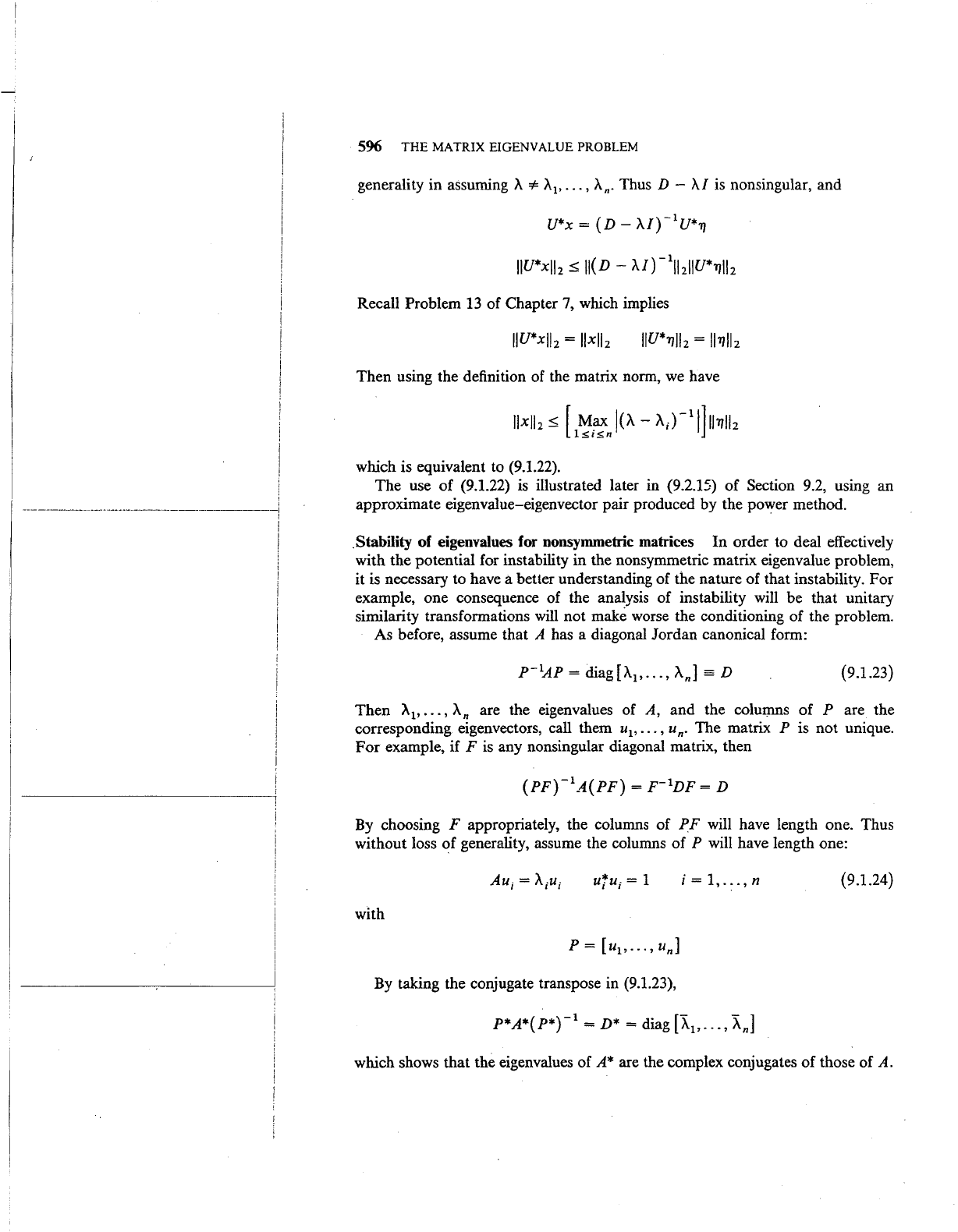
'
--·--·--------··-----·-----------------1
I
i
I
I
596
THE
MATRIX EIGENVALUE PROBLEM
generality in assuming
'A
-=F
'A
1
,
•••
,
'An.
Thus D -
'AI
is nonsingular, and
Recall Problem 13
of
Chapter 7, which implies
IIU*xlb
=
llxlb
Then
using the definition of the matrix norm, we have
which is equivalent to (9.1.22).
The
use
of
(9.1.22) is illustrated later in (9.2.15)
of
Section 9.2, using
an
approximate eigenvalue-eigenvector
pair
produced
by
the power method.
.Stability
of eigenvalues for nonsymmetric matrices
In
order to deal effectively
with the potential for instability
in
the nonsymmetric matrix eigenvalue problem,
it is necessary to have
a better understanding
of
the nature
of
that
instability.
For
example,
one
consequence
of
the analysis
of
instability will
be
that
unitary
similarity transformations will
not
make worse the conditioning
of
the problem.
As before, assume
that
A has a diagonal
Jordan
canonical form:
{9.1.23)
Then
'A
1
,
•..
,
'An
are the eigenvalues of A,
and
the columns
of
P are
the
corresponding eigenvectors, call them u
1
,
•.•
, un.
The
matrix P is
not
unique.
For
example,
ifF
is any nonsingular diagonal matrix, then
By choosing
F appropriately, the columns
of
PF
will have length one. Thus
without loss
of
generality, assume the columns
of
P will have length one:
ujui
= 1
i = 1,
...
, n (9.1.24)
with
p = [
ul'
...
' u
n]
By taking the conjugate transpose in (9.1.23),
which shows
that
the eigenvalues
of
A* are the complex conjugates
of
those
of
A.

--·--------
EIGENVALUE I..:OCATION,
ERROR,
AND
STABILITY RESULTS 597
Writing
(9.1.25}
we have
i =
1,
...
, n
(9.1.26}
Equivalently, by forming the conjugate transpose,
w;*A
=
A;w;*
(9.1.27}
This says
w;*
is
a left eigenvector
of
A,
for
the
eigenvalue
A;.
Since
p-lp
=I,
and
since
we have
* -
{1
W;
uj-
0
i=j
i=Fj
(9.1.28)
This says
the
eigenvectors { u;}
of
A and the eigenvectors {
W;}
of A* form a
biorthogonal set.
N orrnalize the eigenvectors W; by
Define
W;
v.=--
1
llw;ll2
(=
1,
...
,n
1
s-=v~u.=--
1 I I
IIW;Ib
a positive real number. The matrix
(P*)-
1
can now be written
And
i =
1,
...
, n
(9.1.29}
(9.1.30)
We now examine the stability
of
a simple eigenvalue
Ak
of
A. Being simple
means that A k has multiplicity one as a root
of
the characteristic polynomial
of
A.
The
results can be extended to eigenvalues
of
multiplicity greater than one,
but
we omit that case. Consider the perturbed matrix
A(t:)=A+t:B
t:>O

------·-------------~
I
I
598
THE
MATRIX
EIGENVALUE PROBLEM
for some matrix B, independent of
£.
Denote the eigenvalues of A(€)
by
A.
1
(E),
...
, >..,(€). Then
We will prove that
p-l_A(i)P = D +
€C
1
c;j =
-vjBuj
S;
1 s
i,j
s n (9.1.31)
(9.1.32)
The derivation of this result uses the Gerschgorin Theorem
9.1.
We also need
to note
that
for any nonsingular diagonal matrix
F,
and this leaves the eigenvalues of A(€) unchanged. Pick F as follows:
i = k
i * k
(9.1.33}
with
a a positive constant
to
be determined later. Most
of
the coefficients of the
matrix (9.1.33) are not changed, and only those in row
k and column k need to
be considered. They are
j=l=k
j=k
Apply Theorem
9.1
to the matrix (9.1.33). The circle centers and radii are
center
=
A;+
EC;;
rk
= £
2
a L lckjl
j<Fk
(9.1.34)
i * k
We wish to pick a so large and f sufficiently small so as to isolate the circle about
A.k +
t:ckk
from the remaining circles, and in that way, know there
is
exactly one
eigenvalue of (9.1.33) within circle
k.
The distance between the centers of circles
k and i
=I=
k
is
bounded from below
by
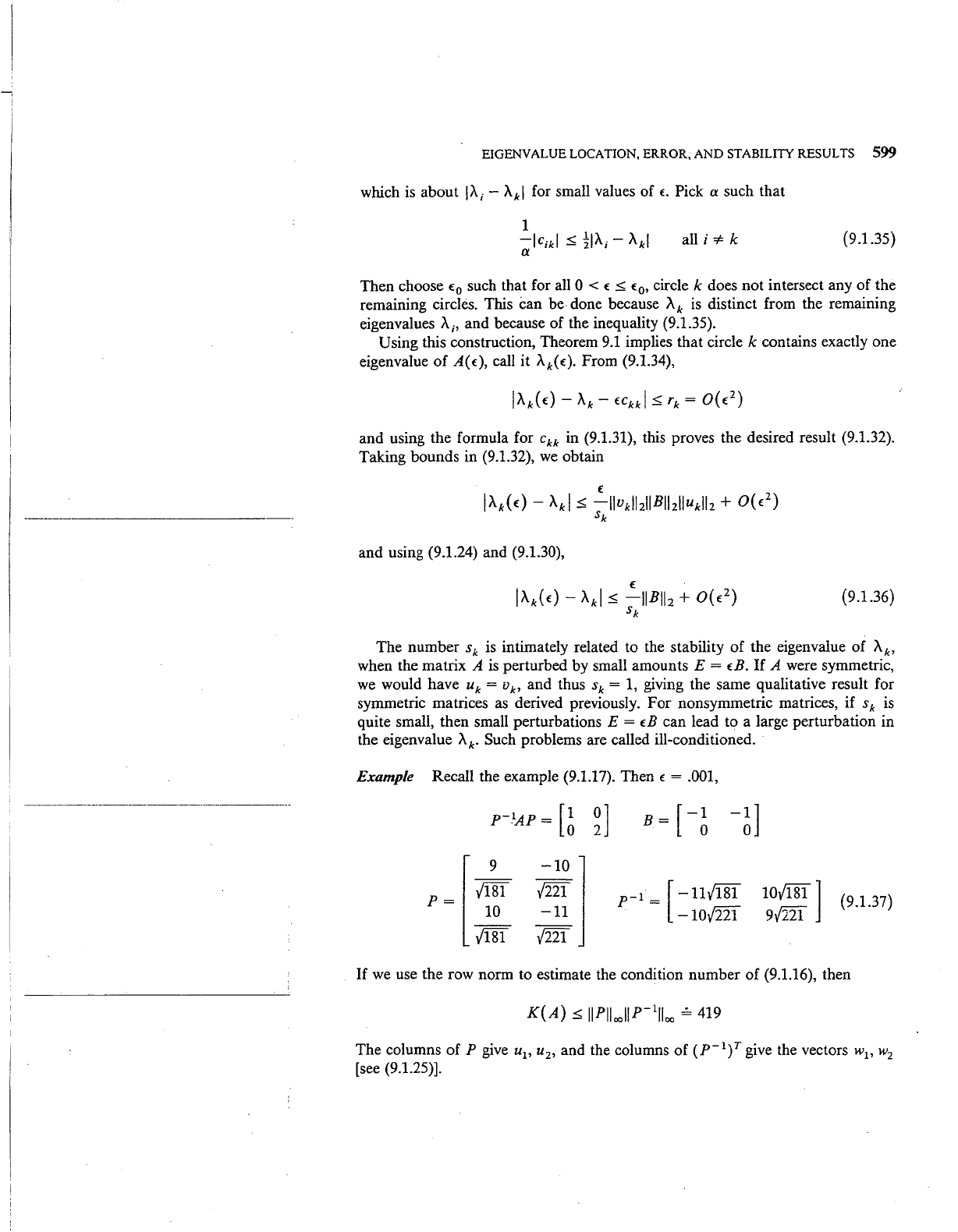
EIGENVALUE LOCATION, ERROR,
AND
STABILITY RESULTS
599
which
is
about IA.i-
A.ki
for small values
of£.
Pick a such that
(9.1.35)
Then choose
t:
0
such that for all 0 <
E:
;5;
t:
0
,
circle k does not intersect any of the
remaining circles. This
can be done because A k
is
distinct from the remaining
eigenvalues
A.i,
and because of the inequality (9.1.35).
Using this construction, Theorem
9.1
implies that circle k contains exactly one
eigenvalue
of
A(t:), call it Ak(t:). From (9.1.34),
and using the formula for ckk in (9.1.31), this proves the desired result (9.1.32).
Taking bounds in (9.1.32),
we
obtain
and using
(9.1.24) and (9.1.30),
(9.1.36)
The number
sk
is intimately related to the stability of the eigenvalue of
A.k,
when the matrix A
is
perturbed by small amounts E =
t:B.
If
A were symmetric,
we
would have
uk
=
vk,
and thus
sk
=
1,
giving the same qualitative result for
symmetric matrices
as
derived previously. For nonsymmetric matrices, if
sk
is
quite small, then small perturbations E =
t:B
can lead to a large perturbation in
the eigenvalue
A.k.
Such problems are called ill-conditioned.
Example Recall the example (9.1.17). Then
t:
= .001,
P=[~
10
v1s1
-10
l
v221
-11
J221
B=
[
-1
0
p-1=
[-nJis1
-1ov221
1oV181
]
~
(9.1.37)
9v221
If
we
use the row norm to estimate the condition number of (9.1.16), then
The columns of
P
give
u
1
,
u
2
,
and the columns of
(P-
1
)T
give the vectors w
1
,
w
2
[see (9.1.25)].
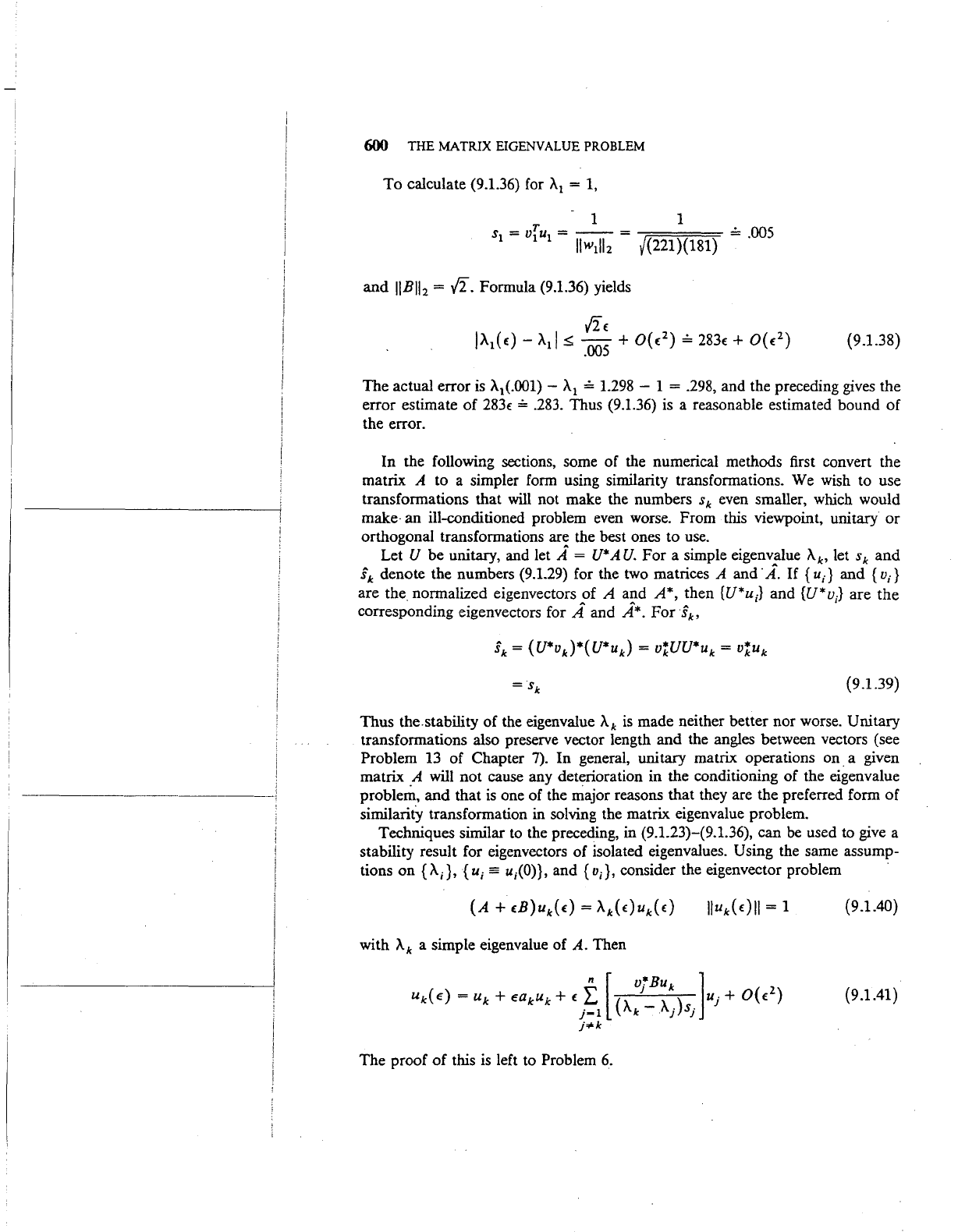
600
THE
MATRIX EIGENVALUE PROBLEM
To
calculate (9.1.36) for ;\
1
= 1,
1 1
s
1
= v[ u
1
=
--
=
--;:;=====:==;:::=;:=-
=
.005
Uw1lh
/(221)(181)
and
IIBII
2
= .fi. Formula (9.1.36) yields
(9.1.38)
The
actual
error
is ;\
1
(.001) - ;\
1
= 1.298 - 1 = .298, and the preceding gives
the
error
estimate
of
283t:
= .283. Thus (9.1.36) is a reasonable estimated
bound
of
the
error.
In
the following sections, some
of
the numerical methods first convert the
matrix
A to a simpler form using similarity transformations. We wish to use
transformations
that
will not make the numbers s k even smaller, which would
make·
an
ill-conditioned problem even worse.
From
this viewpoint, unitary
or
orthogonal transformations are the best ones
to
use.
Let
U
be
unitary, and let A=
U*AU.
For
a simple eigenvalue
;\k•
let sk
and
sk
denote
the numbers (9.1.29) for the two matrices A
and·
A.
If
{
u,.}
and
{
v,.}
are
the. normalized eigenvectors
of
A
and
A*,
then
{U*u,.}
and
{U*u,.}
are
the
corresponding eigenvectors for A
and
A*.
For
§k,
(9.1.39)
Thus
the.stability
of
the eigenvalue
A.k
is
made neither
better
nor worse.
Unitary
transformations also preserve vector length
and
the angles between vectors (see
Problem 13
of
Chapter 7).
In
general,
unitary
matrix operations on. a given
matrix
A will
not
cause any deterioration in the conditioning
of
the eigenvalue
problem,
and
that
is
one of the major reasons
that
they are the preferred form
of
similarity transformation in solving the matrix eigenvalue problem.
Techniques similar to the preceding, in (9.1.23)-(9.1.36),
can
be used to give a
stability result for eigenvectors
of
isolated eigenvalues. Using the same assump-
tions
on
{ ;\,.), {
u,.
=
u,.(O)},
and
{
v;
},
consider the eigenvector problem
(9.1.40)
with
;\k
a simple eigenvalue
of
A. Then
(9.1.41)
The
proof
of
this is left to Problem
6.
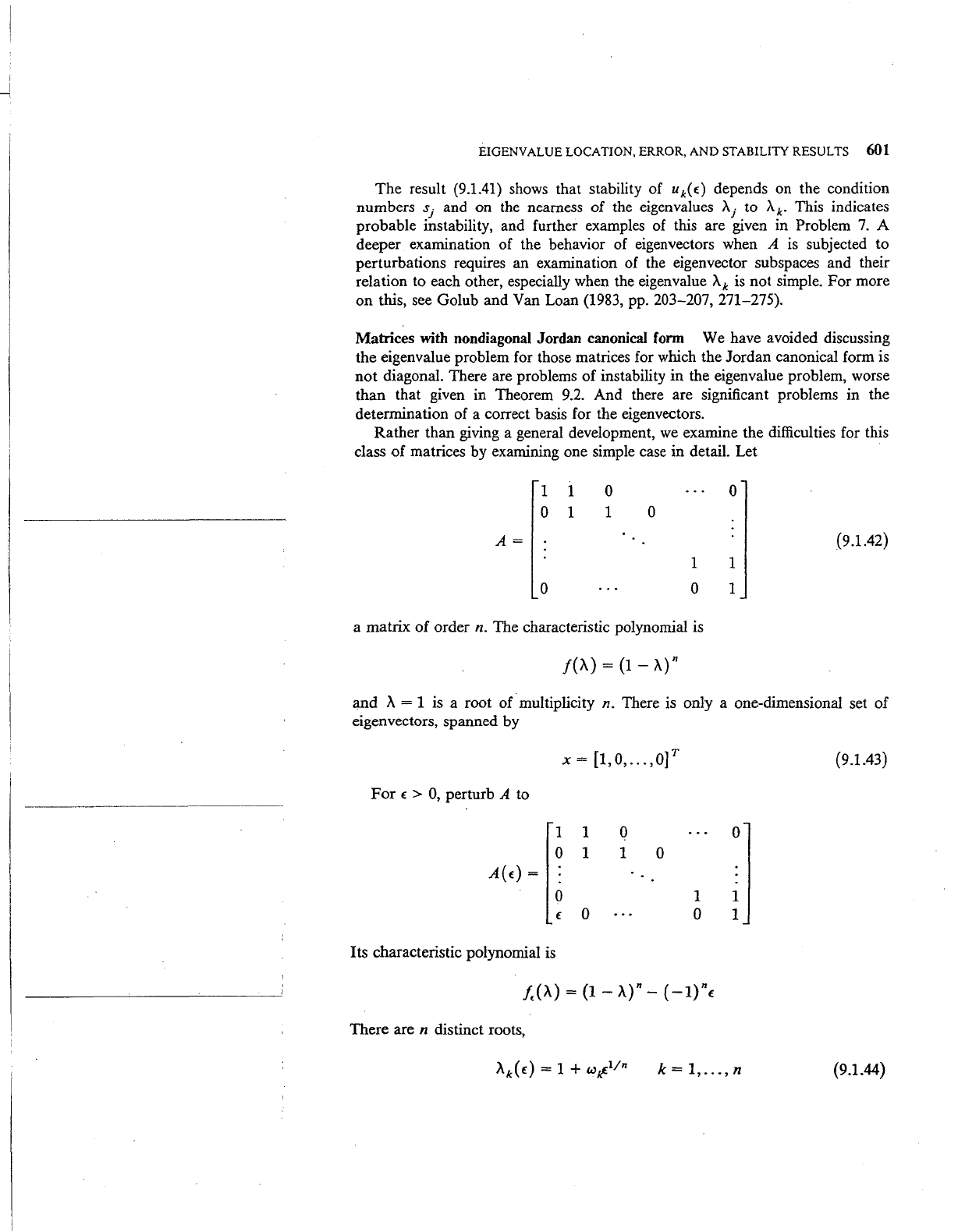
I
~
EIGENVALUE LOCATION, ERROR, AND STABILITY RESULTS 601
The
result (9.1.41) shows that stability of uk(£) depends on the condition
numbers
s
1
and on the nearness
of
the eigenvalues
>..
1
to
A.k.
This indicates
probable
instability, and further examples of this are given in Problem
7.
A
deeper
examination of the behavior of eigenvectors when A is subjected
to
perturbations requires an examination
of
the eigenvector subspaces and their
relation to each other, especially when the eigenvalue
A.k
is
not
simple.
For
more
on
this, see Golub
and
Van Loan (1983, pp. 203-207, 271-275).
Matrices
with nondiagonal Jordan canonical form We have avoided discussing
the
eigenvalue problem for those matrices for which
the
Jordan
canonical form is
not
diagonal. There are problems
of
instability
in
the eigenvalue problem, worse
than
that given in Theorem 9.2.
And
there are significant problems in
the
determination
of
a correct basis for the eigenvectors.
Rather
than
giving a general development, we examine the difficulties for this
class
of
matrices by examining one simple case
in
detail. Let
1
1
0 0
0
1
1 0
A=
(9.1.42)
1
1
0
0
1
a
matrix
of
order
n.
The
characteristic polynomial is
t(>..)
=
(1-
>..r
and
A.
= 1 is a root
ofmultiplicity
n. There is only a one-dimensional set
of
eigenvectors,
spanned
by
X=
[1,0,
...
,0]T
(9.1.43)
For
£ > 0, perturb A to
1
1 0
0
0
1 1
0
A(£)=
0 1 1
(
0
0 1
Its characteristic polynomial is
There
are n distinct roots,
k=
1,
...
, n
(9.1.44)
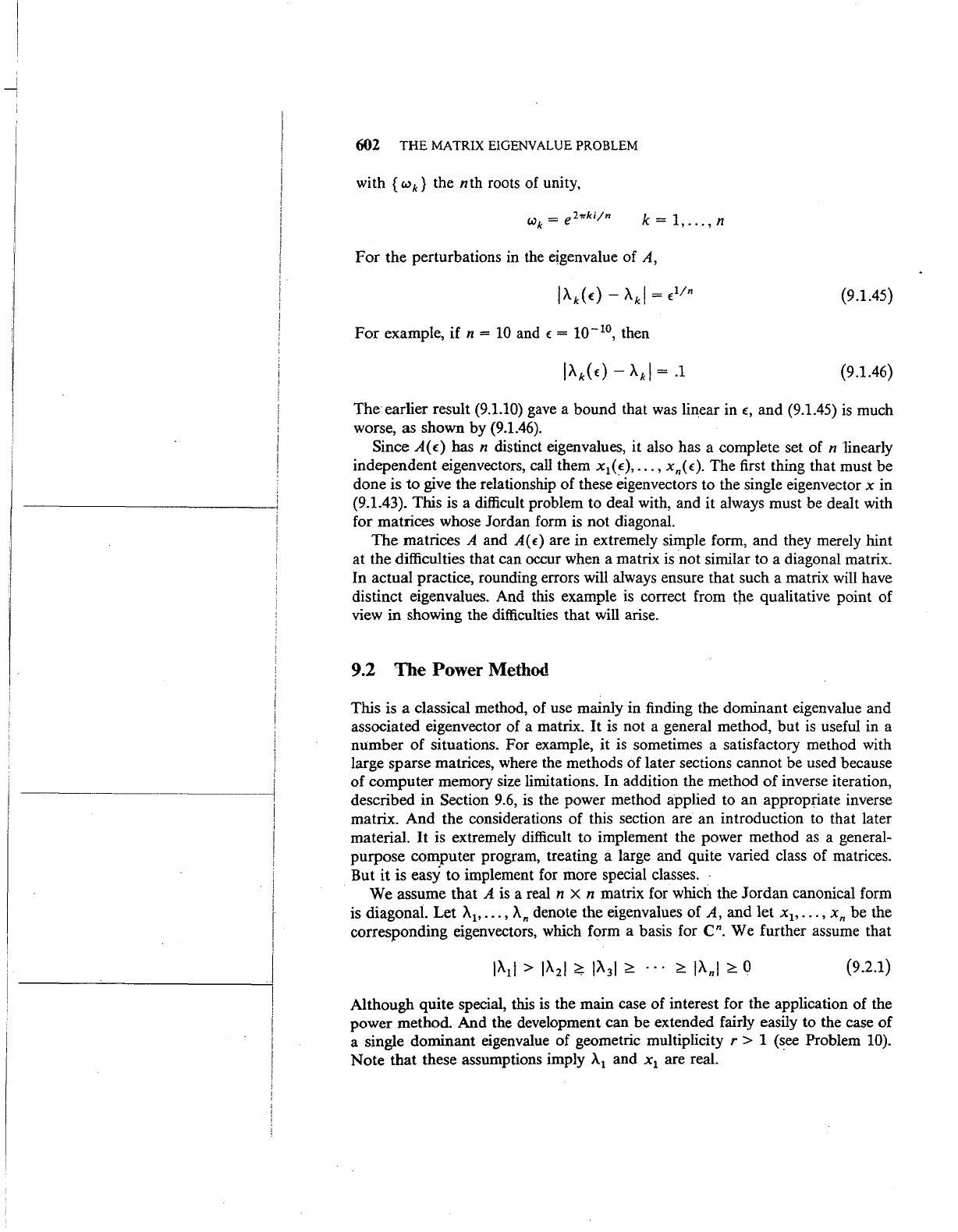
!
I
602
THE
MATRIX EIGENVALUE PROBLEM
with { wk} the
nth
roots of unity,
k = 1,
...
, n
For
the perturbations in the eigenvalue of A,
(9.1.45)
For example, if n =
10
and
~:
=
10-
10
,
then
(9.1.46)
The earlier result (9.1.10)
gave
a bound that was linear in
€,
and (9.1.45)
is
much
worse, as shown by
(9.1.46).
Since
A(~:)
has n distinct eigenvalues, it also has a complete set of n linearly
independent eigenvectors, call them
x
1
(~:),
•••
,
xn(~:).
The first thing that must be
done is
to
give the relationship of these eigenvectors to the single eigenvector x in
(9.1.43). This is a difficult problem to deal with, and it always must be dealt with
for matrices whose Jordan form
is
not diagonal.
The
matrices A and
A(~:)
are in extremely simple form, and they merely hint
at the difficulties that can occur when a matrix
is
not similar to a diagonal matrix.
In actual practice, rounding errors will always ensure that such a matrix will have
distinct eigenvalues. And this example
is
correct from t]le qualitative point of
view in showing the difficulties that will arise.
9.2 The Power
Method
This is a classical method, of use mainly in finding the dominant eigenvalue and
associated eigenvector of a matrix.
It
is
not a general method, but
is
useful in a
number
of
situations. For example, it is sometimes a satisfactory method with
large sparse matrices, where the methods of later sections cannot be used because
of computer memory size limitations. In addition the method
of
inverse iteration,
described in Section
9.6,
is
the power method applied to an appropriate inverse
matrix.
And
the considerations of this section are an introduction to that later
material.
It
is extremely difficult to implement the power method as a general-
purpose computer program, treating a large and quite varied class of matrices.
But it is
easy to implement for more special classes.
We assume that
A
is
a real n X n matrix for which the Jordan canonical form
is diagonal. Let
X
1
,
..•
,
Xn
denote the eigenvalues of
A,
and let x
1
,
...
, xn be the
corresponding eigenvectors, which form a basis for
en.
We further assume that
(9.2.1)
Although quite special, this
is
the main case of interest for the application of the
power method. And the development can be extended fairly easily to the case of
a single dominant eigenvalue of geometric multiplicity
r > 1 (see Problem 10).
Note that these assumptions imply X
1
and x
1
are real.
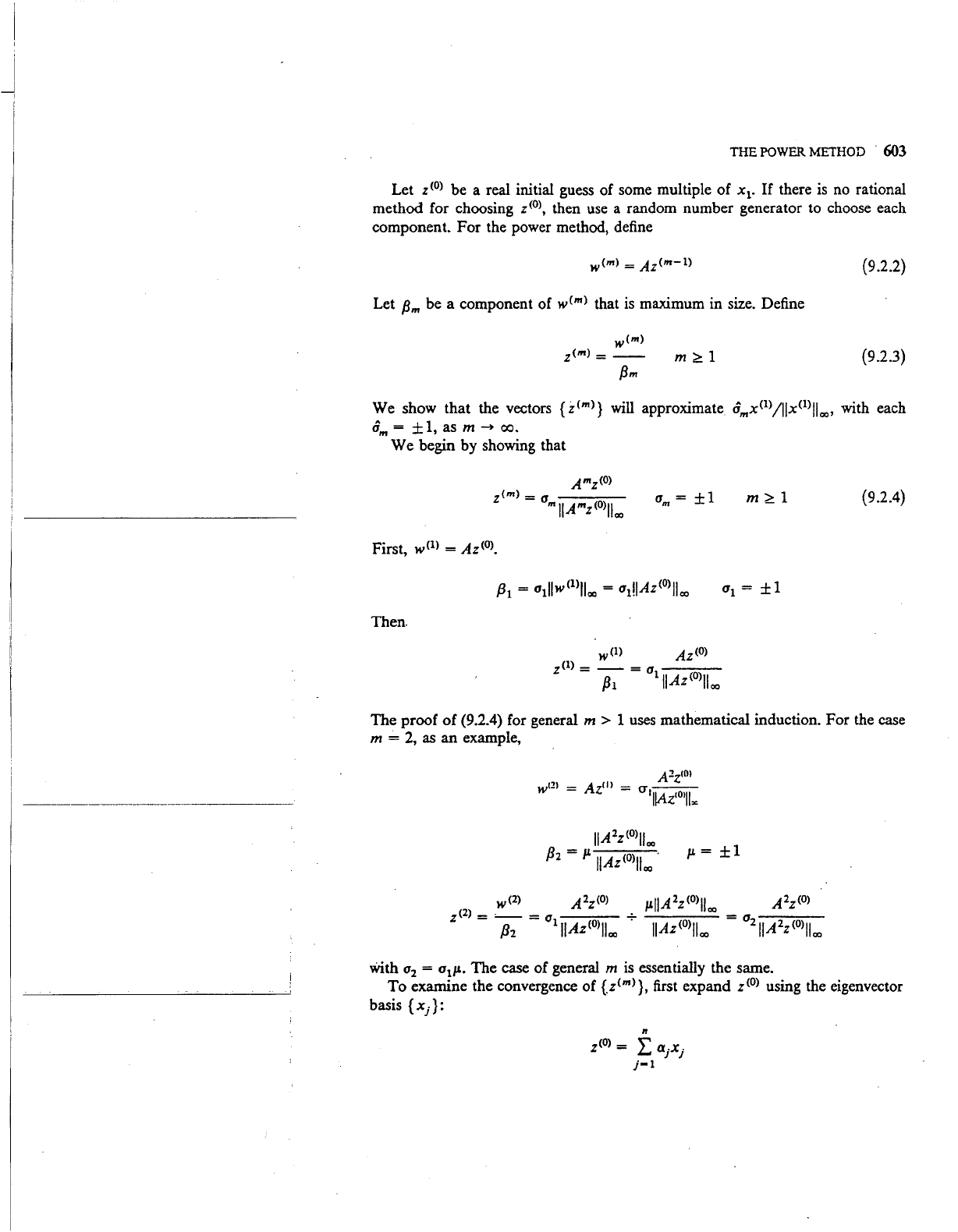
J
I
THE
POWER METHOD .
603
Let
z<
0
> be a real initial guess of some multiple of x
1
•
If
there
is
no
rational
method for choosing
z<
0
>,
then
use
a random number generator to choose each
component. For the power method, define
w<m)
=
Az<m-1)
Let
/3m
be a component of
w<m>
that
is
maximum in size. Define
w<m>
z(m)
=
--
{3m
m
~
1
(9.2.2)
{9.2.3)
We show that the vectors {
.z<m>}
will
approximate
a'"x<
1
>
/llx(l>lloo,
with each
am
= ± 1, as m
__.
co.
We begin by showing that
m
~
1
(9.2.4)
First,
w<
1
> =
Az<
0
>.
Then.
The proof
of
(9.2.4) for general m > 1
uses
mathematical induction. For the case
m =
2,
as an example,
}l
= ±1
With
a
2
= a
1
Jl.
The case of general m
is
essentially the same.
To
examine the convergence of
{.z<m>
},
first
expand
z<
0
> using the eigenvector
basis
{xi}:
n
z<
0
> = L aixi
j-1
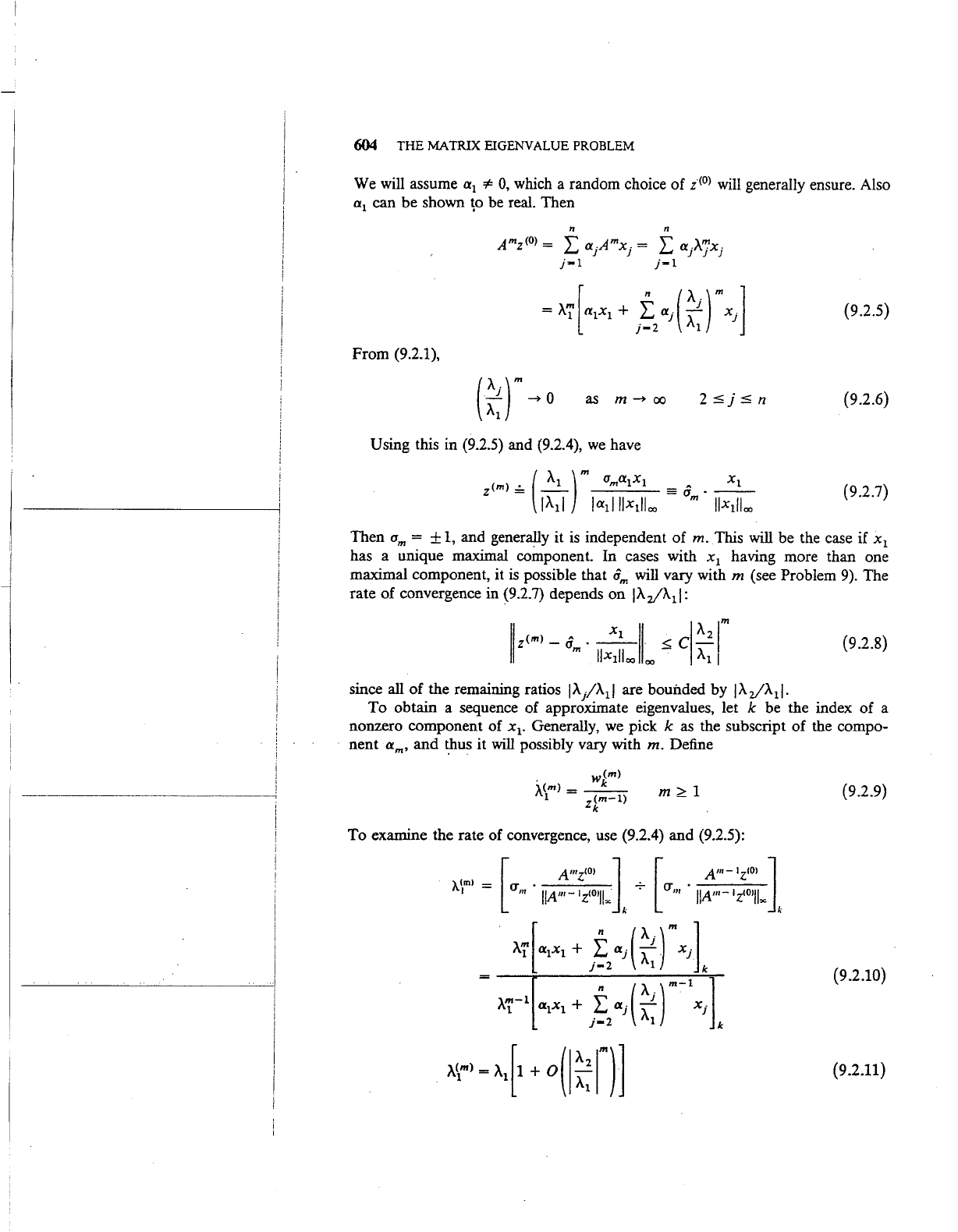
-----
-----------,
604
THE
MATRIX EIGENVALUE PROBLEM
We
will assume a
1
=F
0,
which a random choice of
z<o>
will
generally ensure. Also
a
1
can be shown
~o
be real. Then
(9.2.5)
From (9.2.1),
(~~
r
~
0
2
sj
s n
(9.2.6)
(9.2.7)
Then
am
= ±
1,
and generally it
is
independent of m. This will be the case if x
1
has a unique maximal component. In cases with x
1
having more than one
maximal component, it
is
possible that
am
will vary with m (see Problem
9).
The
rate of convergence in
(9.2.7) depends on
IA:z/Ad:
ll
z<m>-
am.
--..:2_11-
~
ci
A2
r
llx1ll
oo oo
>-1
I
(9.2.8)
since all of the remaining ratios lA/AII are bounded by
IA:z/Ad.
To obtain a sequence of approximate eigenvalues, let k be the index of a
nonzero component of x
1
.
Generally,
we
pick k as the subscript of the compo-
nent
am,
and
~us
it
will
possibly vary with
m.
Define
W
(m)
. k
A(m)=
--
1
z<m-1)
k
m
~
1
To examine the rate of convergence, use (9.2.4) and (9.2.5):
\(ml
_
"-1 -
(9.2.9)
(9.2.10)
(9.2.11)

THE
POWER METHOD 605
The rate of convergence
is
linear, and it depends
on
IA.21A.tl.
The index k is
usually chosen
fixed.
If
we
choose k as the index of the maximal component am
of
w<m>,
and if x
1
has a single maximum component, then k will become
constant as
m
-+
oo.
With more than one maximal component, it can move
about, as is shown in
Problem
9.
An alternative method of defining
A.\m>
is
given
in Conte and de Boor
(1980,
p. 192), avoiding the need to select a particular
component index:
The
·vector u
is
to satisfy uTx
1
=1=
0,
and a random choice of u
will
generally
suffice. The error in
A.\m)
will
again satisfy (9.2.11).
Example Let
(9.2.12)
The true eigenvalues are
A
1
= 9.623475383 A
2
= - .6234753830 (9.2.13)
An ,initial guess
z<
0
> was generated with a random number generator. The first
five
iterates are shown in Table
9.1,
along with the ratios
A_(m) _
)\(m-1)
R = 1 1
m
)\(m-1)
_
A_(m-2)
1 1
(9.2.14)
The iterates
A)m>
were
defined using (9.2.9), with k =
3.
According to a later
discussion, these ratios should approximate
the ratio
A21A.
1
as m
-+
co.
We use the computable error bound (9.1.22) that
was
derived earlier
in
Seetion
9.1. Calculate
1J
=Ax-
Ax
with
X
=x(S)
Table 9.1 Example of the power method
m
zl"'l
z~m)
z(m)
3
"}..(m)
1
1
.50077
.75038
1.0000
11.7628133
2 .52626
.76313
1.0000 9.5038496
3 .52459
.76230
1.0000
9.6313231
-.05643
4
.52470
.76235
1.0000 9.6229674
-.06555
5
.52469
.76235
1.0000 9.6235083
-.06474
